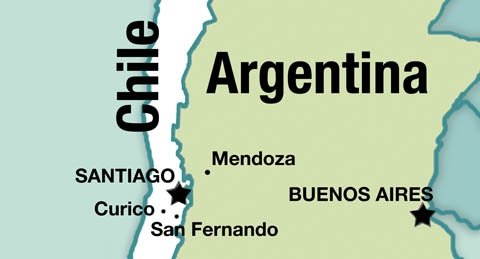
It’s pretty safe to say that Chilean sweet cherries, which begin shipping around the time many of us start thinking about Christmas shopping, will never pose a threat to Pacific Northwest cherry growers.
In fact, say some, Chilean cherries can actually give Northwest cherry production a shot in the arm because they set the stage for the Northwest harvest that follows in five to six months.
Growers who attended the Oregon Horticultural Society’s cherry talks in Portland recently got a short course on sweet cherry production in Chile from a man who’s been involved for a number of years.
Juan Pablo Zoffoli, a professor at Pontificia Universidad Catolica de Chile in Santiago, told the growers that South American countries closer to the equator are more concerned with growing tropical fruit than cherries, but Chile and Argentina are concentrating more on temperate fruit.”
At this time, only Chile and, to a much lesser extent, Argentina are growing cherries in South America in any quantity, Zoffoli said. In Chile, 9,000 hectares, about 22,500 acres, are devoted to the crop.
Zoffoli said that in Argentina the Mendoza area in mid-country, around 50 miles east of Santiago, Chile, grows “very nice cherries” for early markets. “But they have a lot of problems with rain and hail.”
Exported
In 2007, Chile harvested 40,000 metric tons of cherries, 80 percent of which were exported. The remainder were mainly processed for domestic consumption.
“The domestic market is not important to us,” Zoffoli said. “It’s not going to take much of what we produce. We are looking for high-income countries to sell our high-price, high-quality fruit to.”
Unlike the United States, where cherry production begins in California and proceeds north, production in Chile starts in the northern part of the growing area, which is closer to the equator, and proceeds south.
While Curico was and still is the major cherry-growing area in Chile, about 20 years ago numerous acres began going in 100 miles north, around Santiago, the capital, and San Fernando. The reason for the move north was to take advantage of the warmer weather that rewarded growers with earlier harvests.
Zoffoli said that cherry production in Chile is expected to double in the next ten years.
The Chilean sweet cherry harvest, which is all hand picked, begins in late October/early November and wraps up as late as January 15. The biggest chunk of the crop is exported around the middle to the end of November.
In good orchards, yields of 15 tons per hectare, or six tons per acre, are the norm, Zoffoli said. While yields of 20 tons per hectare are possible, “the quality goes down.”
High density
Quality is especially an issue in high-density orchards if trees have not been properly trained, Zoffoli said. Overcropping leads to problems such as small fruit and pitting.
Most of the cherries being planted now in Chile are in high-density orchards, Zoffoli said. “It’s the same as what’s happening in the states.”
Since most South American countries are not very affluent, Chilean cherries end up being shipped by sea, and occasionally by air, to North America, Europe, and parts of Asia, primarily China. It can take up to 50 days for Chilean cherries to reach their farthest markets, Zoffoli said.
Zoffoli, 43, who has a master’s degree in horticulture from Oregon State University, said one of the challenges to growing cherries in the north of Chile is having enough chilling hours during the winter.
Chile, which began ramping up its sweet cherry industry in the mid-1970s, leads all other Southern Hemisphere countries in production, Zoffoli said. He added that because shipping distances are so great, maintaining quality during transit is a major issue.
As in the United States, Bing is the predominant variety grown in Chile, followed by Lapins. Growers have been planting a lot of Sweetheart. The earliest variety is Santina.
Year-round
Retired Washington State University agricultural economist Dr. Desmond O’Rourke said in a phone interview that Chilean cherries, as well as those from emerging producers around the world, play an important role in creating more demand for the fruit all year round in the U.S. market.
There are concerns, however, that lower quality fruit from offshore could have just the opposite effect and turn off U.S. consumers. “The quality has been very variable,” O’Rourke said. “I’ve heard that complaint for a couple of years.”
Not helping quality issues any is the relatively long time it takes Chilean cherries to reach U.S. supermarkets, usually between 20 and 30 days.
O’Rourke said that the Chileans, like U.S. and Turkish cherry growers, are aiming to stretch their season by expanding production north and south.
One up and coming cherry-growing country in the Southern Hemisphere is South Africa.”One of the biggest apple growers in South Africa is planting sweet cherries,” O’Rourke reported.
While they are sending few if any cherries to the United States at this time, the production in Southern Hemisphere countries other than Chile is growing very rapidly from a very low base, O’Rourke said.

Very good report on Cherry expanding production in Chile
Interesting to know. As one that is very familiar with cherry production in NW Michigan tart cherries you might be surprised to know that more and more cherry acres are being converted to grapes for wine in the Leland county and other areas around Traverse City< MI. However, I don’t think grapes in my life time will replace cherries. That is a good thing.